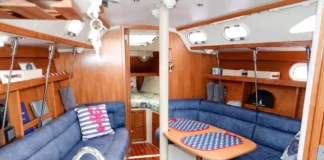Weve sewn our fair share of eyes in nylon webbing, but heres an easy no-sew alternative for creating a webbing strap with a buckle (shackle) that can be used for easily lashing down the dinghy, a battery, or even holding up your pants in a pinch. It is based on stuff a sailor has on hand-webbing, a chain link, and a shackle-and is as strong as professionally sewn ends, plus it can be untied after loading. It has tested at greater than 85-percent breaking strength and 100 percent of minimum rate strength, and it works on both nylon and ultra-high strength materials like Vectran webbing.

Step 1: Double the end of the webbing and thread it through the eye of a chain link twice. The link will need to be at least 5/16-inch to have room for both strands. We used grade 30 link, but any higher grade should do. The shackle must have width for the webbing. We used a 5/16-inch shackle and 15-millimeter webbing; a 3/8-inch shackle is required for 1-inch webbing.
Step 2: Put the shackle pin through the hole.
Step 3: Dress it up. The top strand should be loaded (longer radius) as it is about 10-percent stronger.
If the webbing is wrapped around the other end of the shackle, there is no space between the chain link and the shackle, causing a shear point; the webbing will fail at about 50- to 60-percent breaking strength, which is still better than most knots and much easier to untie. On the other hand, if the webbing is properly wrapped around the pin (as shown in the accompanying photos), the metal surrounding the pin creates the required gap between the link and the pin, preventing shearing.
The no-sew strap could work loose under cyclic load, so a backup knot is suggested in these uses. As long as there is some load, it will not slip. We do not recommend using this for safety-related applications, like connecting jacklines to the deck. The shackle also could scratch nearby gelcoat, so use a chafe guard when required.








































